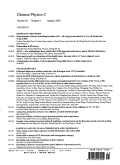- 钛学术文献服务平台 \
- 学术期刊 \
- 基础科学期刊 \
- 物理学期刊 \
- 中国物理C(英文版)期刊 \
null
MONTE CARLO EVENT GENERATORS
基本信息来源于合作网站,原文需代理用户跳转至来源网站获取
摘要:
General-purpose Monte Carlo (GPMC) generators like HERWIG [1],HFRWIG++ [2],PYTHIA 6 [3],PYTHIA 8 [4],and SHERPA [5],provide fully exclusive simulations of high-energy collisions.They play an essential role in QCD modeling (in particular for aspects beyond fixed-order perturbative QCD),in data analysis,where they are used together with detector simulation to provide a realistic estimate of the detector response to collision events,and in the planning of new experiments,where they are used to estimate signals and backgrounds in high-energy processes.They are built from several components,that describe the physics starting from very short distance scales,up to the typical scale of hadron formation and decay.Since QCD is weakly interacting at short distances (below a femtometer),the components of the GPMC dealing with short-distance physics are based upon perturbation theory.At larger distances,all soft hadronic phenomena,like hadronization and the formation of the underlying event,cannot be computed from first principles,and one must rely upon QCD-inspired models.

推荐文章
期刊_丙丁烷TDLAS测量系统的吸收峰自动检测
带间级联激光器
调谐半导体激光吸收光谱
雾剂检漏 中红外吸收峰 洛伦兹光谱线型
不同盐度、温度及光照对漂浮浒苔生理生态的影响
浒苔
盐度
温度
光照
生理生态
期刊_联合空间信息的改进低秩稀疏矩阵分解的高光谱异常目标检测
高光谱图像
异常目标检测 低秩稀疏矩阵分解 稀疏矩阵 残差矩阵
内容分析
关键词云
关键词热度
相关文献总数
(/次)
(/年)
文献信息
| 篇名 | MONTE CARLO EVENT GENERATORS | ||
| 来源期刊 | 中国物理C(英文版) | 学科 | |
| 关键词 | |||
| 年,卷(期) | 2016,(10) | 所属期刊栏目 | |
| 研究方向 | 页码范围 | 540-549 | |
| 页数 | 10页 | 分类号 | |
| 字数 | 语种 | 中文 | |
| DOI | |||
五维指标
引文网络
引文网络
二级参考文献 (0)
共引文献 (0)
参考文献 (0)
节点文献
引证文献 (0)
同被引文献 (0)
二级引证文献 (0)
2016(0)
- 参考文献(0)
- 二级参考文献(0)
- 引证文献(0)
- 二级引证文献(0)
引文网络交叉学科
相关学者/机构
期刊影响力
中国物理C(英文版)
主办单位:
中国物理学会
中国科学院高能物理研究所
中国科学院近代物理研究所
出版周期:
月刊
ISSN:
1674-1137
CN:
11-5641/O4
开本:
出版地:
北京市玉泉路19号(乙)中国科学院高能物理研究所内 北京918信箱
邮发代号:
创刊时间:
语种:
eng
出版文献量(篇)
3629
总下载数(次)
0
总被引数(次)
2764
期刊文献
相关文献
推荐文献
- 期刊分类
- 期刊(年)
- 期刊(期)
- 期刊推荐
力学
化学
地球物理学
地质学
基础科学综合
大学学报
天文学
天文学、地球科学
数学
气象学
海洋学
物理学
生物学
生物科学
自然地理学和测绘学
自然科学总论
自然科学理论与方法
资源科学
非线性科学与系统科学
中国物理C(英文版)2022
中国物理C(英文版)2021
中国物理C(英文版)2020
中国物理C(英文版)2019
中国物理C(英文版)2018
中国物理C(英文版)2017
中国物理C(英文版)2016
中国物理C(英文版)2015
中国物理C(英文版)2014
中国物理C(英文版)2013
中国物理C(英文版)2012
中国物理C(英文版)2011
中国物理C(英文版)2010
中国物理C(英文版)2009
中国物理C(英文版)2008
中国物理C(英文版)2016年第9期
中国物理C(英文版)2016年第8期
中国物理C(英文版)2016年第7期
中国物理C(英文版)2016年第6期
中国物理C(英文版)2016年第5期
中国物理C(英文版)2016年第4期
中国物理C(英文版)2016年第3期
中国物理C(英文版)2016年第2期
中国物理C(英文版)2016年第12期
中国物理C(英文版)2016年第11期
中国物理C(英文版)2016年第10期
中国物理C(英文版)2016年第1期

 免费查重
免费查重










